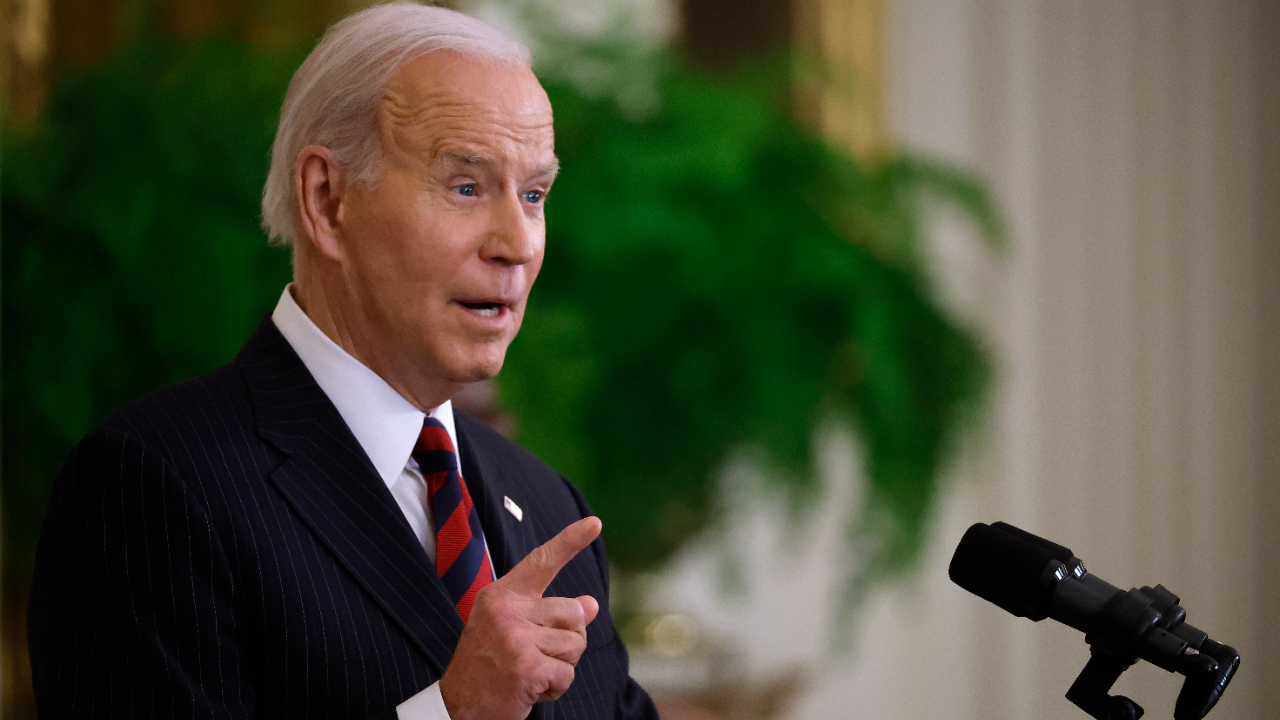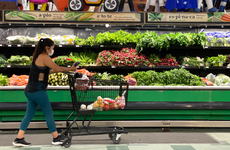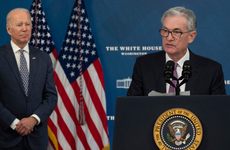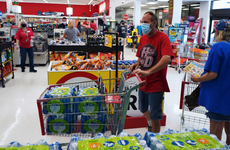How is the U.S. economy doing? With inflation hitting 40-year highs, watch these 4 key areas

The Bankrate promise
At Bankrate we strive to help you make smarter financial decisions. While we adhere to strict , this post may contain references to products from our partners. Here's an explanation for .
Years after living through one of the most abnormal recessions in a lifetime, Americans are getting caught in the middle of an equally bizarre recovery — and there’s no clear blueprint for how the U.S. economy is going to evolve from here.
To be sure, the financial system has made significant progress at rebounding from the coronavirus pandemic-induced plunge in March 2020. Employers for a year now have had a near record number of job openings, the U.S. economy by sheer size is bigger today than before the outbreak and economists are expecting another above-trend year for growth, all flashing a clear green light.
But a yellow caution flag is still waving prominently: Fewer Americans are working today than before the pandemic, and the virus is still threatening global manufacturing, which is weighing heavily on supply chains. And perhaps the brightest light of all — a red one — prices are rising by the fastest rate in 40 years.
All of that means, if the economy resembled any object, it’d likely be a broken traffic light.
Key economic indicators to watch:
- Consumer price index (CPI): 7.9 percent
- Unemployment rate: 3.8 percent
- Jobs added in February: 687,000
- Job openings in January: 11.3 million
- Federal funds rate: 0.25-0.5 percent
- 10-year Treasury yield: 2.29 percent
Here’s four key measures that show what’s happening in the U.S. economy right now and how it could impact your wallet.
1. Prices are rising at the fastest rate in many Americans’ lifetimes — and there’s no telling when they will slow down
Before the pandemic, there was the greatest disappearing act of modern economics: After years of booming job creation and sinking unemployment pre-pandemic, where was the inflation that typically comes along with it?
If consumers ever asked that question, they might be regretting it now.
Price pressures have returned with a vengeance, rising by the fastest rate that many Americans have ever seen. CPI — the closest-watched inflation gauge tracking items that the average American buys — rose by 7.9 percent between February 2021 and February 2022, the fastest annual clip since January 1982.
Used cars (41.7 percent), gasoline (38 percent), energy (25.6 percent), rental vehicles (24.3 percent) and utility services (23.8 percent) were among the items that got the most expensive over the 12-month period. In January 2021, prices soared from a year earlier by a meager 1.4 percent rate.
A March Bankrate survey found that more than 9 in 10 U.S. adults (or 93 percent) have felt inflation take a bite out of their wallet, while almost 3 in 4 say those increases have negatively impacted their wallet.
“Food, electricity and shelter were the biggest contributors, but the increases were pervasive, which virtually any household can tell you,” says Greg McBride, CFA, Bankrate chief financial analyst.
Underneath the hood, inflation broke records and also showed signs of broadening out. Prices on lunch meats, chicken, baby food, household furnishings, men’s apparel and new trucks all rose by a record rate. That was also true for the price of many services: Having a meal out at a restaurant, staying at a hotel room for the night or repairing your vehicle climbed in the month by the quickest pace ever.
The more categories that inflation starts to permeate, the harder it gets to cool down. Economists have long equated inflation to an airplane taking off on the runway. Once it gains speed, it’s very hard to turn around.
Landlords, for example, could see higher energy costs and raise rent, locking in tenants on higher shelter costs for a full year. Workers could start to ask for higher pay if it becomes widespread enough — and it might already be happening according to Zillow, which found in February that a one-year lease cost an average of $3,400 more than it did two years ago.
All of that means inflation could linger for longer, even if supply chain pressures keep gradually easing, as they already have been, according to the New York Fed’s Global Supply Chain Pressure Index.
Supply chain bottlenecks lingered longer beyond lockdowns than most economists expected, as virus cases continued to shut down factories across the globe and worker shortages reduced production. That’s after many Americans ramped up their purchases of goods, flush with cash from stimulus checks and lockdown-induced savings.
“There’s a global traffic jam of goods affecting cargo ships, shipping containers, trucks and railroads. That’s leading to price increases,” says Mark Hamrick, Bankrate senior economic analyst. “Resolution of these complicated supply traffic jams doesn’t seem to be in the cards any time soon.”
But the inflation picture has gotten considerably darker in recent months. Russia invaded Ukraine on Feb. 24, which caused global commodity, gasoline and energy prices to skyrocket. Americans in March paid a record amount for gasoline at the pump, according to AAA. Supply chains could also soon reverse some of their recent improvement, after China in March reinstated COVID-19 lockdowns.
Consumer confidence is already taking a tumble as many Americans start to brace for more inflation, with the closely tracked University of Michigan consumer sentiment index in January dropping to 67.2 percent, the lowest since 2011.
“It continues to seem likely that hoped-for supply-side healing will come over time as the world ultimately settles into some new normal, but the timing and scope of that relief are highly uncertain,” said Federal Reserve Chair Jerome Powell during a March public appearance.
2. The job market is booming, with hiring demand red-hot
Nothing has highlighted more than the pandemic just how interconnected the U.S. economy is — and part of what happens with inflation also has a lot to do with what’s going on in the labor market.
The workforce isn’t up and running at its full pre-pandemic capacity, leading to further mismatches in demand and supply. From the broadest scorecard, the U.S. labor market is 2.2 million jobs short of its February 2020 peak.
Employers have made significant progress, so far recovering 90 percent of the roughly 22 million jobs lost to the outbreak. But rather than the problem being about too-few jobs, the issue is having too-few workers.
Job openings have held at record levels since February 2021, soaring to 11.3 million in January 2022, showing red-hot demand for more workers as consumers entered a post-lockdown economy with big urges to spend, travel and dine out again. Employers have about 1.7 job openings per every unemployed worker, close to a record level.
The sooner employers can fill those positions, the better the outlook for inflation, but firms aren’t having an easy time. About 2.7 percent of workers in the labor force — some 4 million people — quit their jobs in 2021. Data doesn’t show where those workers are going, but most economists say they’re likely leaving for new positions rather than dropping out of the labor force altogether.
A massive rethink about what Americans want out of work — dubbed the “Great Resignation” — dominated headlines amid the jobs boom. Exacerbating the issue, the labor supply also remains compressed, with the share of civilian population in the workforce at the lowest level since 1977.
About half of the shortfall is because of workers retiring, the Federal Reserve said, with 2.6 million more retirements than usual during the pandemic, according to an analysis from economists at the St. Louis Fed. But other problems are likely to do with caretaking challenges and fears about catching the virus. Before the pandemic, labor force participation was 1.1 percentage points higher.
Firms are boosting wages as a result, a long-standing way to tempt more jobseekers. Wages are up 11.17 percent from a year ago for the lowest-paid workers, many of them working production and nonsupervisory positions, according to a Fed analysis. Wages are up 4.25 percent for the country’s highest earners, the analysis also found.
Not everyone is experiencing a booming economy. Black unemployment is nearly twice as high as that of Whites, while Hispanic unemployment is 1.1 percentage points higher, according to data from the Department of Labor.
3. As inflation soars and labor market grows tighter, the Fed is raising interest rates — possibly by the biggest move higher since 2000
But the latest inflation and labor market data aren’t giving the Fed any mixed messages: Officials see an economy that’s running too hot and are starting to dial back how much stimulus they’re providing the financial system. Eventually, markets and economists alike are expecting them to actually start restraining growth, though that will be several rate hikes from now.
The Fed in March lifted interest rates by a quarter point for the first time since 2018 and stopped adding to the money supply. Officials also penciled in six more rate hikes and are preparing to figure out how to start shrinking their massive portfolio of bonds — known as its balance sheet — at an upcoming meeting.
“While interest rate increases are now underway, the more significant step of starting to run off the balance sheet is waiting on deck,” McBride says. “The combination of rate hikes and eventually shrinking their asset portfolio will complete the transition from going full throttle to putting the brakes on the economy.”
The Fed could also go even bigger and bolder with how aggressively it plans to tap the brakes on the economy. Economists at Goldman Sachs are penciling in half-point hikes at the Fed’s May and June meetings — which would be the biggest increases since 2000 — as well as four more quarter-point moves this year. That would take interest rates all the way up to a range of 2.25-2.5 percent, the highest since July 2019.
Powell himself signaled that he was open to that aggressive of a move, saying in a March public appearance that the Fed is willing to raise rates by more than 25 basis points at “a meeting or meetings” if it’s necessary to control inflation.
“There is an obvious need to move expeditiously to return the stance of monetary policy to a more neutral level, and then to move to more restrictive levels if that is what is required to restore price stability,” Powell said.
4. Investors are anxiously watching the yield curve, but the Fed — and economy — isn’t dangerously tied to it
As investors grapple with the likelihood of higher inflation and a more hawkish Fed, many are starting to dump short-term bonds for longer-dated ones, causing shorter-dated yields to rise and longer-dated yields to fall.
The difference between two closely followed yields — the 2-year and 10-year Treasurys, which form what’s called “the yield curve” — are inching closer toward inverting, with the spread now at the tightest since February 2020.
The yield curve is a major financial signal to investors. That’s because 22 recessions have been pre-dated with the yield-curve inverting, according to Anu Gaggar, CFA, senior analyst at Commonwealth Financial Network. Sometimes that’s more correlation than causation. The last time the yield curve inverted in August 2019, for example, no one had ever imagined that the expansion would ultimately come to an end because of a global pandemic. Still, however, the signal is worth watching.
“The inverted yield curve can not only be foretelling of a recession; it can be a catalyst for it,” McBride says. “The fundamental underpinning — not just of banking, but the flow of credit in general — is being able to borrow at short-term rates and lend out at long-term rates. All of a sudden, if short-term rates are higher than long-term rates, the flow of credit slows down dramatically.”
What to do with your finances
Jobseekers have all the power in today’s labor market, whether that’s hunting for a new position or negotiating for more flexibility and higher pay. Workers who switch jobs tend to also see faster wage gains than job stayers, according to the Atlanta Fed’s wage growth tracker.
“Workers may continue to leverage this strong job market, one in which many are seeking higher pay and better conditions, including an added measure of balance between their professional and personal lives,” Hamrick says.
But the more immediate steps to take with your finances all have to do with higher interest rates and inflation. If you’re looking to find a way to make a better return, experts say the most important step is diversifying your assets. Those could be investing in anything from Treasury-Inflation Protected Securities (TIPS) to real estate investment trusts (REITs), two inflation-safe investments historically. Consider avoiding parking all of your cash in fixed income, but having an ample emergency fund in a high-yield savings account is a crucial personal finance step, no matter how high inflation soars.
Pay off your high-interest credit card debt quickly, which could saddle your pocketbook in a rising-rate environment. If you haven’t yet refinanced, the window to find the best deal is quickly closing, with mortgage rates climbing to levels not seen since 2019.
“Consumers can expect higher borrowing costs to be just another form of inflation, with rates for credit cards and home equity lines of credit notching higher in the next month or so,” McBride says.
Learn more:
Related Articles

Survey: Inflation could remain stuck above Fed’s 2% target until 2025

Survey: Has inflation peaked? Here’s what the nation’s top economists say

The worst inflation in 40 years: Here’s when price pressures could hit their peak

Should you be worried about inflation? Here’s what the experts are saying